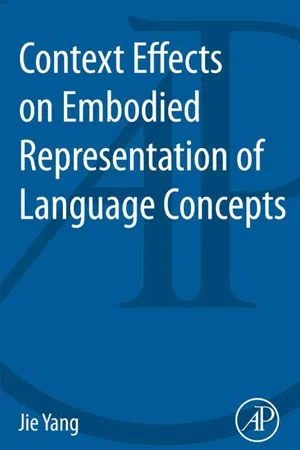![]()
Context Effects on Embodied Representation of Language Concepts
Conceptual knowledge is abstract information representing different categories in the world. It is fundamental for various cognitive functions, such as object recognition, language comprehension and production, knowledge acquisition, decision making, and so on.
Nevertheless, how conceptual knowledge is represented and processed in the human brain is still unknown. Although amodal theories assume that concepts resides in a modular semantic system separate from modality-specific systems for perception and action (Fodor, 1975; Pylyshyn, 1984; Smith & Medin, 1981; Tulving, 1972), increased evidence from behavioral, electroencephalographic (EEG)/magnetoencephalographic (MEG), functional magnetic resonance imaging (fMRI), and transcranial magnetic stimulation (TMS) studies indicate that representation of conceptual knowledge is grounded in modality-specific systems, and brain regions underpin perception and action are also involved in conceptual processing. These findings suggest that representation of concepts is grounded in the sensory–motor system.
One debate about the embodied representation is whether it is stable, that is, whether it is independent of linguistic or extra-linguistic context. Although conceptual knowledge is traditionally assumed to be stable and retrieved from memory in a situational invariant fashion, many researchers have claimed that the embodied representation is context dependent and flexible (Barsalou, 2003; Kiefer, 2005; Yeh & Barsalou, 2006) given the fact that different contexts can emphasize different semantic features in the concepts.
This chapter reviewed theories about the automaticity or contextual flexibility of embodied representation and the evidence supporting of these theories. Subsequently, three issues were raised about the current evidence: first, whether the flexibility happens in the presemantic stages (i.e., the stages where the sensory–motor system makes functional contributions to semantic processing) are still in controversy. Second, specific influences from different contexts on embodied representation still need to be distinguished. Third, influences from metalinguistic tasks used in the current studies need to be investigated and clarified.
1.1 Theories About Automatic Embodied Representation
So far several theories have claimed the automaticity of embodied representation. Pulvermüller (1999) proposed that neurons in different cortical areas active at the same time can form cell assemblies that are strongly connected. The distribution of the cell assemblies in the brain reflects how neurons are activated during learning. Words in different categories all include a left lateralized perisylvian part representing phonological word form, and neurons outside the perisylvian areas are added to assembly if words refer to actions and perceptions. For action words, a perisylvian assembly is linked to neurons in motor, premotor, and prefrontal cortices related to motor program. For object words, a perisylvian assembly and neurons in visual cortices are linked to represent perception meanings.
Pulvermüller (2001) mentioned that during word acquisition, in neurons representing word forms and neurons representing stimuli, the words referred to are repeatedly active at the same time. Thus, they tend to be associated and activity in one can facilitate activity in the other. Because word-form processing can be fast and automatic (Krause et al., 1998), neurons related to motor or perception processes referred to by words can be automatically and invariably activated when action or perception words are encountered.
Pulvermüller (2005) discussed the neural mechanism of comprehending action-related words. One important issue is whether the comprehension of the action words can specifically, rapidly, and automatically activate the motor system in a somatotopic manner. The author claimed a semantic somatotopy model. According to the model, the perception of spoken and written action words can activate brain regions responsible for action planning and execution in a category-specific somatotopic fashion. The internal connections of the neuronal assemblies are achieved through fast-conducting axons, and thus the spread activation from word-form perception areas to the sensorimotor areas related to the referred meaning is rapid and early. Furthermore, this fast activation is automatic and does not require people pay attention to the language stimuli.
1.2 Theories About Context-Dependent Embodied Representation
Theories about flexible embodied representation assume that involvement of the sensory–motor system in conceptual representation is context dependent, and can be modified by linguistic or extra-linguistic factors.
Simmons, Hamann, Harenski, Hu, and Barsalou (2008) proposed that language comprehension relies on both the language and the situated simulation (LASS) system. The language system is responsible for processing word-form information, and the situated stimulation system is responsible for representing conceptual knowledge. When a word is presented, both systems are activated but the language system peaks first. After the word-form information is recognized by the language system, the word’s representation begins to activate simulations contributing to the word’s meaning. Although the model assumes that these simulations are often activated automatically and quickly, it also claims that different task demands can cause different mixtures of LASS: when word-form information is sufficient to support task performance, word processing will mostly rely on the language system and little on the situated simulation system; when word-form information alone cannot sufficiently support task performance (e.g., the task requires semantic judgment), the situated simulation system will be activated to provide conceptual information. Task demand therefore ca...
